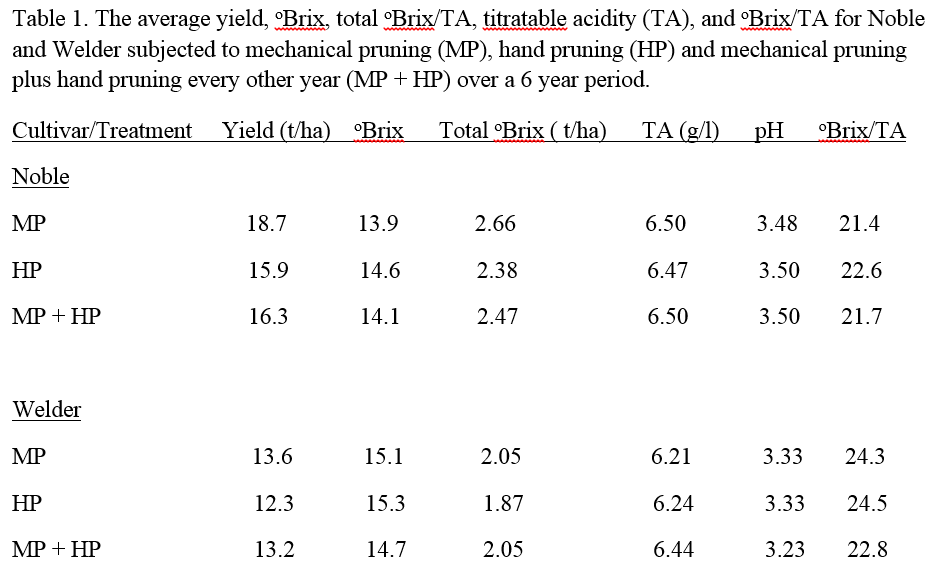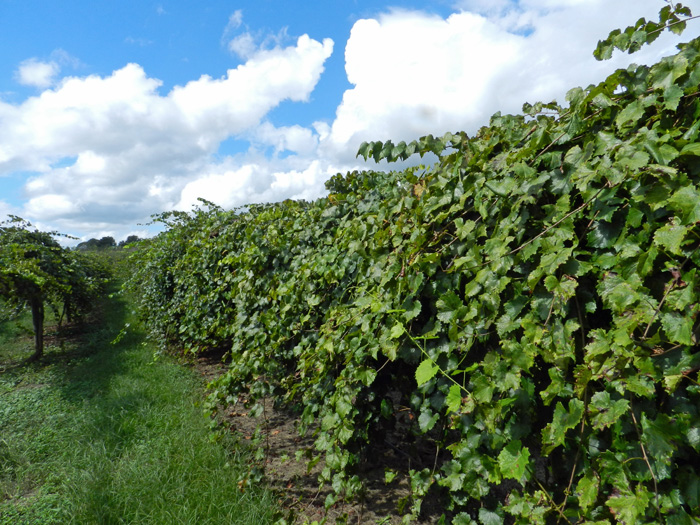Muscadine grapes (Vitis rotundifolia Michx.) subgenus Muscadinia are different from European and American bunch grapes (subgenus Euvitis) in chromosome number, vine and berry morphology, and juice characteristics. In contrast to Euvitis grapes, very little data is available concerning training and pruning methods. A two wire vertical training (2WV), a single wire bilateral cordon (BC) and a Geneva double curtain (GDC) training system are often used. The BC system is most common in Florida. The GDC training system has typically resulted in the highest yield, although this system has the highest labor and maintenance costs.
For the commercial production of muscadine grapes, mechanization of pruning and harvest operations is essential for grapes destined to be processed into juice or wine. Fresh market grape production (U-pick, roadside stand, or direct market sales) is primarily limited to large fruited grape cultivars. Although some muscadine grape growers are currently using mechanized pruning, there is little information on the long term effects on yield and berry quality.
A replicated trial of Noble (purple grape) and Welder (bronze grape) muscadine grapevines was established at the North Florida Research and Education Center. The purpose of the study was to evaluate the influence of mechanical pruning (MP) (using a gas-powered hedge trimmer), hand pruning (HP), and MP every year followed by HP every other year (MP + HP) on yield and berry quality of Noble and Welder grapes over a six year period. The treatments represent a minimum (MP), an intermediate (MP + HP) and a maximum (HP) labor requirement.
Average yield across all treatments varied from 16 to 19 t/ha for Noble, to 12 to 14 tons/hectare (t/ha) for Welder (Table 1). (Note that table 1 only contains average values). When data from all years was combined and statistically analyzed, pruning treatment did not influence yield, or berry °Brix, titratable acidity, total °Brix/ha, °Brix/titratable acidity, or pH, with the exception of °Brix of Noble (highest for the HP treatment). ((Note: °Brix is the sugar content of a solution. One degree Brix (°Brix) is 1 gram of sucrose (sugar) in 100 grams of solution. It is used to measure sweetness levels in, for example, grapes, sugarcane, etc.))
By contrast, the effect of year was significant for all variables for all cultivars. For MP Noble, yield and °Brix/ha decreased linearly with time. The MP treatment resulted in increasingly tangled spur and shoot growth for both cultivars. Both Noble and Welder subjected to the SMP + HP treatment displayed a strong tendency to bear heavy and light crops in alternate years, with lower yields recorded in years that HP was employed.
 The labor cost of HP was at least 5 times greater than that of MP. This cost differential would be much greater for commercial pruning utilizing a tractor mounted sickle bar. Light touch up pruning every year or a 90° alteration of an asymmetric pruning scheme every year may be a better alternative to reduce alternate bearing and achieve long-term sustainable yield and juice quality compared to rather drastic hand pruning in alternate years. In conclusion, mechanized pruning is recommended for muscadine grapes destined for processing into juice or wine.
The labor cost of HP was at least 5 times greater than that of MP. This cost differential would be much greater for commercial pruning utilizing a tractor mounted sickle bar. Light touch up pruning every year or a 90° alteration of an asymmetric pruning scheme every year may be a better alternative to reduce alternate bearing and achieve long-term sustainable yield and juice quality compared to rather drastic hand pruning in alternate years. In conclusion, mechanized pruning is recommended for muscadine grapes destined for processing into juice or wine.
For further information see the following UF/IFAS Resources:
The Muscadine Grape
UF/IFAS Mid-Florida Research and Education Center, Grapevine Genetics and Plant Pathology Research Laboratories
- Impact of Hurricane Winds on Citrus Varieties Being Evaluated in Quincy - September 20, 2019
- Quincy Citrus Variety Evaluation Update - March 29, 2019
- Impact of Hurricane Winds on Pecan Varieties - November 2, 2018

